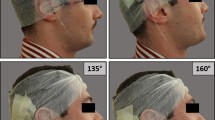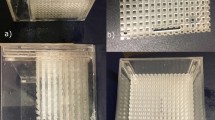Abstract
Purpose
A new generation of cochlear implant (CI) magnets and specific surgical techniques (e.g., implant positioning) has changed the relationship between a CI and magnet resonance imaging (MRI). MRI allows a pain free in vivo evaluation of the inner ear fluid state and internal auditory canal after the insertion of an electrode. The aim of this study is to evaluate how the patient’s head position in the MRI scanner influences the CI magnet-related artefact.
Methods
We performed in vivo measurement of MRI artefacts at 3 T with a CI system containing a bipolar diametrical magnet. The implant magnet was positioned with a head bandage at different positions from the nasion and external auditory canal in three volunteers. We used a turbo spin echo (TSE) T2w sequence on the axial and coronal planes and observed three positions: (1) regular position, (2) chin to chest (anteflexion), and (3) hyperextension (retroflexion).
Results
By comparing the positions, anteflexion of the cervical spine in a chin-to-chest position allowed us to place the artefact in a more apical position from the IAC in the coronal plane. The hyperextension of the cervical spine position shifts the artefact father towards the cochlea’s direction.
Conclusion
The head’s position can influence the location of MRI artefacts. In cases where the artefact diminished the IAC or cochlea, anteflexion of the cervical spine in the chin-to-chest position of the head in the MRI scanner should be attempted to allow a visualization of the IAC.




Similar content being viewed by others

References
Portnoy WM, Mattucci K (1991) Cochlear implants as a contraindication to magnetic resonance imaging. Ann Otol Rhinol Laryngol 100(3):195–197
Grupe G, Wagner J, Hofmann S, Stratmann A, Mittmann P, Ernst A et al (2016) Prevalence and complications of MRI scans of cochlear implant patients. HNO 64(3):156–162. https://doi.org/10.1007/s00106-016-0128-8
Hassepass F, Stabenau V, Maier W, Arndt S, Laszig R, Beck R, Aschendorff A (2014) Revision surgery due to magnet dislocation in cochlear implant patients: an emerging complication. OtolNeurotol 35(1):29–34. https://doi.org/10.1097/MAO.0b013e3182a5d2c5
Bo GK, ** WK, Jeong JP, Kim SH, Kim HN, Choi JY (2015) Adverse events and discomfort during magnetic resonance imaging in cochlear implant recipients. JAMA Otolaryngol Head Neck Surg 141(1):45–52. https://doi.org/10.1001/jamaoto.2014.2926
Todt I, Tittel A, Ernst A, Mittmann P, Mutze S (2017) Pain free 3 T MRI scans in cochlear implantees. Otol Neurotol 38(10):e401–e404. https://doi.org/10.1097/MAO.0000000000001569
Walton J, Donnelly NP, Chuen TY, Joubert I, Durie-Gair J, Jackson C et al (2014) MRI without magnet removal in neurofibromatosis type 2 patients with cochlear and auditory brainstem implants. OtolNeurot 35:821–825. https://doi.org/10.1097/MAO.0000000000000330
Todt I, Rademacher G, Mittmann P, Wagner J, Mutze S, Ernst A (2015) MRI artifacts and cochlear implant positioning at 3 T in vivo. OtolNeurotol 36(6):972–976. https://doi.org/10.1097/MAO.0000000000000720
Stratmann A, Mittmann P, Rademacher G, Grupe G, Hoffmann S, Mutze S, Ernst A, Todt I (2017) MRI-based estimation of scalar cochlear-implant electrode position. Biomed Res Int 2017:6372704. https://doi.org/10.1155/2017/6372704
Tek F, Müller S, Boga E, Gehl HB, Seitz D, Scholtz LU, Sudhoff H, Todt I (2019) 3 T high resolution MRI based estimation of scalar cochlear implant electrode position. Acta Otol Ital 39:269–273. https://doi.org/10.14639/0392-100X-2309
Sudhoff H, Gehl HB, Scholtz LU, Todt I (2020) MRI observation after intralabyrinthine and vestibular schwannoma resection and cochlear implantation. Front Neurol. https://doi.org/10.3389/fneur.2020.00759
Grupe G, Rademacher G, Hofmann S, Stratmann A, Mittmann P, Ernst A et al (2017) Evaluation of cochlear implant receiver position and its temporal changes. Otol Neurotol 38(10):e558–e562. https://doi.org/10.1097/MAO.0000000000001521
Author information
Authors and Affiliations
Corresponding author
Ethics declarations
All procedures performed in studies involving human participants were in accordance with the ethical standards of the institutional and/or national research committee and with the 1964 Helsinki Declaration and its later amendments or comparable ethical standards.
Additional information
Publisher's Note
Springer Nature remains neutral with regard to jurisdictional claims in published maps and institutional affiliations.
Rights and permissions
About this article
Cite this article
Ay, N., Gehl, H.B., Sudhoff, H. et al. Effect of head position on cochlear implant MRI artifact. Eur Arch Otorhinolaryngol 278, 2763–2767 (2021). https://doi.org/10.1007/s00405-020-06349-1
Received:
Accepted:
Published:
Issue Date:
DOI: https://doi.org/10.1007/s00405-020-06349-1



